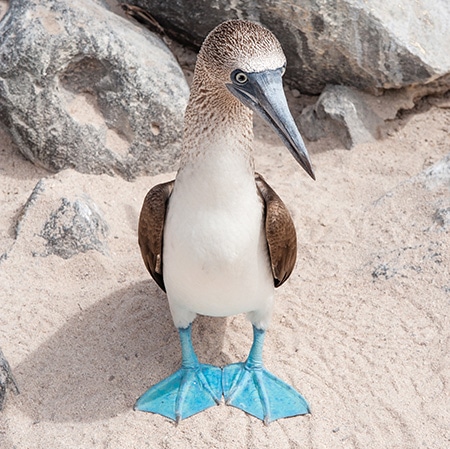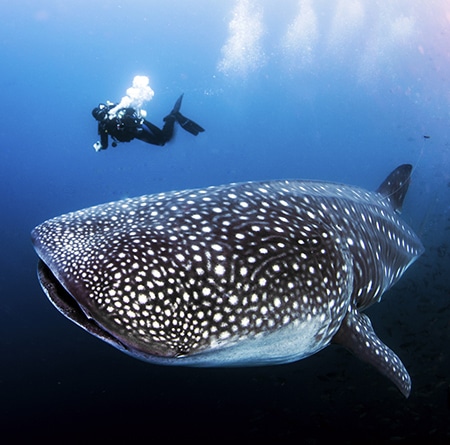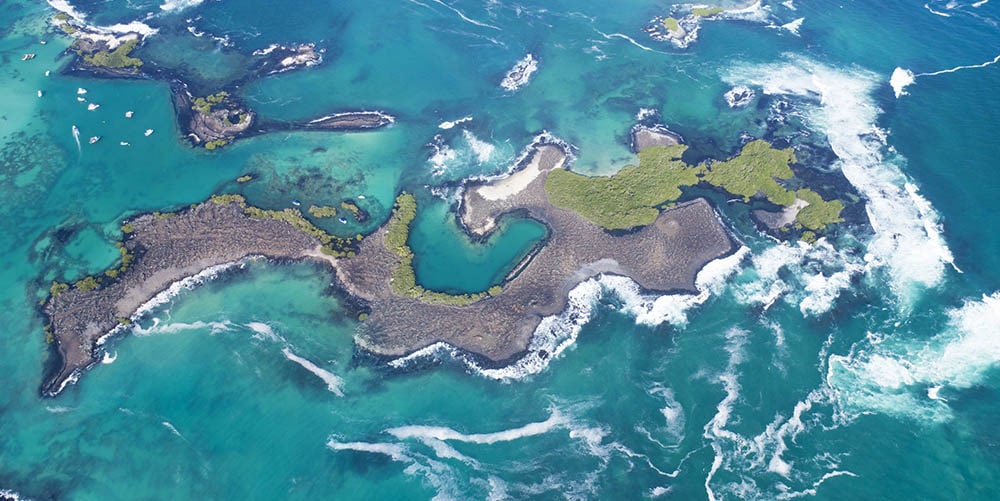Mary Lussiana and her teenage son Justin head to the Galapagos Archipelago, a dream destination for adventurous families in search of nature in the raw.
‘Nothing could be less inviting than the first appearance. A broken field of black basaltic lava, thrown into the most rugged waves..’ noted Charles Darwin in his diary upon arriving in the Galapagos Archipelago in September 1835. Nothing much has changed then, I thought, as we came in to land – the final leg in a long journey across the globe. Yet these islands, which became key to Darwin’s theory of evolution by natural selection, became for me, within minutes of touching down, the most fascinating I have ever visited.
Firstly, it’s the sheer volume of unimpeded wildlife. Giant tortoises (and there are 22,000 of them) roam, land iguanas slump, one on top of the other, under the shade of giant cacti; marine iguanas bask on the black rocks, almost invisible until they sneeze, expelling the sea salt from their bodies. Sea lions clamber up shorelines, inquisitive and sociable, (see them at the local fishing market on Santa Cruz island, butting the legs of the fisherwoman, just like a Labrador might, to ask for titbits), whilst Sally Lightfoot crabs, so startlingly, vividly, orange, scuttle in packs at the sea’s edges.


Blue-footed Booby standing on sand on Espanola, the Galapagos
That is land, but under the water, you will find Surgeonfish and Damselfish, Moorish idols and Chocolate chip sea stars; beautiful Pacific green turtles and hideous Streamer hogfish, white tipped reef sharks, whale sharks and if you are lucky, as we were tiny penguins streamlined, rocket like, flashing past.
In the air, wheeling above you at any one time will be frigate birds, their lack of webbed feet meaning they need to steal the catch of other birds to survive, blue footed boobies and red-billed tropicbirds and around you on the ground will be chattering mocking birds and any one of the fourteen different Darwin’s finches. It was these, which Darwin brought home with him to study, which made him realise that the variations in the birds had been brought about by the habitat where they were existing (i.e. the beak of the finch which lived on an island filled only with cacti had evolved to be able to fit between the spines).
Then, it is the fact that there are no real indigenous people; that 97% of the Galapagos is National Park and the few people who do live here are restricted to the remaining 3%. And most of all it is the knowledge, the passion and the determination of those few to preserve these islands for the future. This means doing without a car, having to collect rainwater for domestic use, being vigilant about every seed and pip which could suddenly, like the blackberry or the guava become too invasive and change the eco-system. It is a constant process and one in which the conservationists are still learning. They introduced a bird from the mainland called ‘smooth billed annie’ to control ticks on the cattle only to find that they are the ones who have spread the blackberry. Right now they are trying to find how to control the Philornis downsi fly which arrived accidentally from Trinidad & Tobago and whose eggs are laid in the nests of birds, developing into larvae which then feeds off the chicks, causing significant mortality to song birds. And so it goes on…

Dive with whale sharks in the Galapagos between June and December
If there was ever a place to take a child for them to understand the importance of conservation, the Galapagos are surely it, for the crucial need for preservation is tangible. But any child will get far, far more from these ‘enchanted islands’ (so called by sailors who sometimes saw them and sometimes didn’t through the mist) than that. They will, as Justin was, be knocked off balance by the unusual feeling that we are in the minority; they will get the rare pleasure of swimming completely freely with sea lions, of climbing over sleeping iguanas and watching octogenarian, giant tortoises stroll towards them. They will learn about evolution, about flora and fauna and about geology. And for us parents? It will not be the pleasure of seeing the world through our child’s eyes but the pleasure of seeing it together, side by side, in a sea of turtles and tortoises.

Las Tintoreras, Isla Isabela, Galapagos Islands, Ecuador
It’s a good idea to listen to the suggestions of your hotel, who will most likely have boats which cruise between the islands. Whilst the wildlife is distributed between islands, hotels are mainly on Santa Cruz and here too are giant tortoises, sea lions, marine iguanas, Sally Lightfoot crabs and many birds. To see land iguanas you need to go to Santiago Island, to see colonies of blue footed boobies and penguins you should go to Fernandina and so on, so choose carefully what your priorities are.
Recently refurbished Finch Bay Eco Hotel (www.finchbayhotel.com) is the only hotel right on the beach and makes a comfortable base, with friendly staff.
Pikaia Lodge (www.pikaialodge.com) is the islands most luxurious hotel, situated in the highlands, with excellent food and its own yacht to transport guests to the islands.
The sea can be rough so take sea sickness pills with you, and you should also be aware of possible altitude sickness.
There is a $20 transit card fee, payable in cash from the departing airport
There is a National Park entrance fee at Customs to get into the Galapagos which you need to pay in cash.